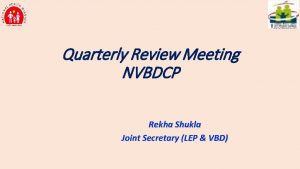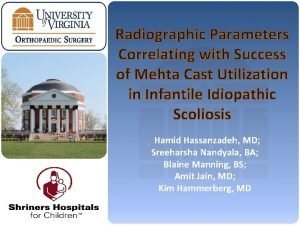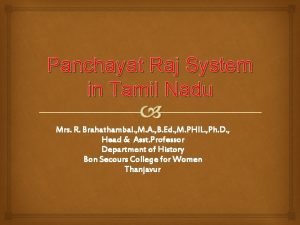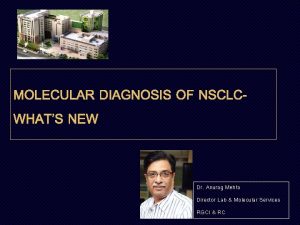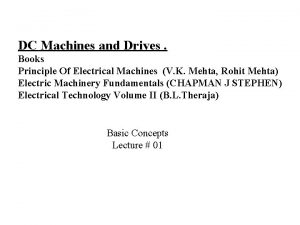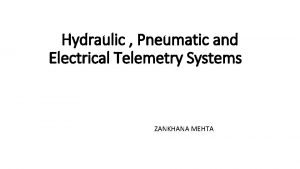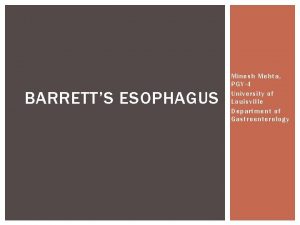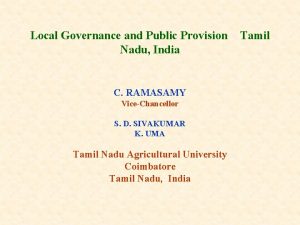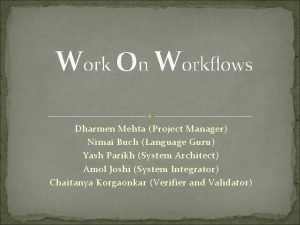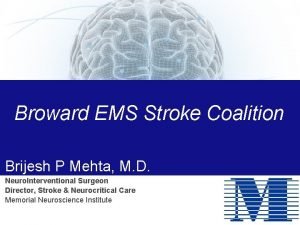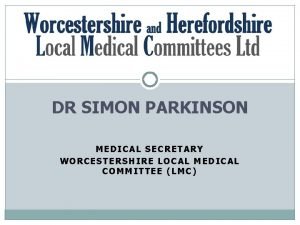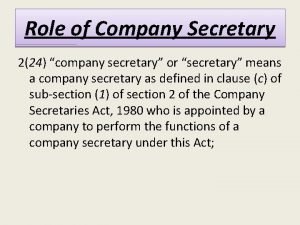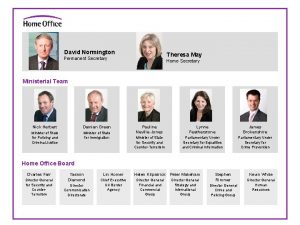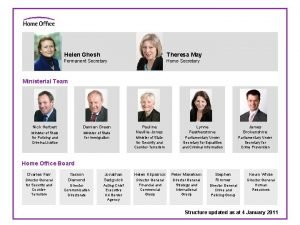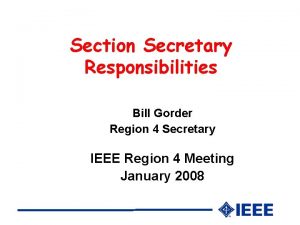Dr Vishwas Mehta Joint Secretary Medical Education HR





![Current Scenario of HR – Contd…. 3. Allied Health Professionals [AHP] (such as Lab Current Scenario of HR – Contd…. 3. Allied Health Professionals [AHP] (such as Lab](https://slidetodoc.com/presentation_image/93b4735c240921af958cca0da6ada520/image-6.jpg)























![q Increase of around 17, 400 MBBS seats annually [total as per two schemes] q Increase of around 17, 400 MBBS seats annually [total as per two schemes]](https://slidetodoc.com/presentation_image/93b4735c240921af958cca0da6ada520/image-30.jpg)


- Slides: 32

Dr. Vishwas Mehta Joint Secretary Medical Education & HR 9/26/2020 Challenges of Human Resources in Health 1

1. 2. 3. 4. Current scenario of Human Resources Current Scenario of Infrastructure Trends and Ratios Reforms and Next steps 9/26/2020 Presentation Plan 2

3 9/26/2020

Current Scenario of HR 1. DOCTORS Doctor per 1000 population Compared to China 1. 6, USA – 2. 6, UK – 2. 3, Sweden – 3. 3 9/26/2020 • Number of Doctors – 8. 58 lakh (as per IMR) • Those available (75%) – 6 to 6. 5 lakh (approx) • Doctor Population Ratio – 1: 1953 (Current) Target ratio– 1: 1200 by 2025 • Additional Doctors required – 4. 2 lakh by 2022 1. 5 lakh in 50000 PHCs 0. 8 lakh in 12500 CHCs 1. 1 lakh in 5642 SDH/DH 0. 5 lakh in 800 MCHs 4. 2 Lakh by 2020 4

Current Scenario of HR –contd… 2. NURSES 9/26/2020 • Nurses registered – 11. 2 lakh • Available – 9 lakh (Approx) • Nurse-Population Ratio – 0. 4 : 1000 • Nurses +ANM Vs Doctor Ratio – 1. 5 : 1 (Desired 3: 1) • Brazil – 3: 1, South Africa – 5: 1, USA 3: 1, UK 5: 1 Target – 1: 2. 19 by 2025 • Additional Nurses required – 16. 2 lakhs by 2022 5
![Current Scenario of HR Contd 3 Allied Health Professionals AHP such as Lab Current Scenario of HR – Contd…. 3. Allied Health Professionals [AHP] (such as Lab](https://slidetodoc.com/presentation_image/93b4735c240921af958cca0da6ada520/image-6.jpg)
Current Scenario of HR – Contd…. 3. Allied Health Professionals [AHP] (such as Lab tech. Radio tech, Med Record tech, Rehab , Ophthalmic tech…. to name a few) 9/26/2020 • Allied Health Workforce available – 62. 65 lakhs (Approx) • Additional Workforce required – 64. 1 lakhs State-wise short-fall Approximately 34 lakh AHPs required in the major states as indicated below 10 5. 28 5. 64 4. 62 4. 22 3. 68 6 Bihar Maharashtra Uttar Pradesh West Bengal Andhra Pradesh Tamil Nadu

Current scenario of Infrastructure Medical colleges 194 45252 161 Medical colleges in the Govt. Sector. Pvt. Sector 45000 40000 35000 30000 25000 20000 15000 10000 5000 0 22194 9/26/2020 195 190 185 180 175 170 165 160 155 150 Total intake capacity of UG seats of PG seats 1 Medical colleges in the Govt. Sector. 161 2 Medical colleges in the Pvt. Sector 194 3. TOTAL Medical Colleges 355 4. Total intake capacity of UG seats 45252 5. Intake capacity of UG excluding non-renewal seats(1300) 43952 6. Total intake capacity of PG seats 22194 7

Current Scenario of Infrastructure – 9/26/2020 Dental Colleges 1 Dental colleges in the Govt. Sector. 41 2 Dental colleges in the Pvt. Sector 256 3. TOTAL 297 4. Total intake capacity of UG seats 24570 5. Total intake capacity of PG seats 4585 8

Current Scenario of Infrastructure – 9/26/2020 ANM and GNM Schools S. No Items 2010 -11 2011 -12 Total 1 No. of ANM Schools sanctioned 51 11 62 (out of 132) 2 No. of GNM Schools sanctioned 39 31 70 (out of 137) 3 No. of States covered 16 10 20 (29) 4 States where no fund released 9 9

9/26/2020 0: 1900000 0: 1300000 0: 1000000 0: 300000 35 0: 200000 0: 64000 1: 124400 1: 115333 1: 85000 30 1: 61403 1: 58000 1: 50814 1: 49680 1: 49294 25 1: 45650 1: 44753 1: 36142 1: 35714 1: 34000 20 1: 25250 1: 24192 1: 21616 1: 20000 1: 18668 15 1: 18000 1: 16700 1: 15107 1: 13500 1: 12979 10 1: 11684 1: 10174 1: 9333 40 3 4 5 6 7 8 9 10 11 12 13 14 15 16 17 18 19 20 21 22 23 24 25 26 27 28 29 30 31 31 32 33 34 Sikkim Goa Karnataka Kerala Tamil Nadu Manipur Andhra Pradesh Delhi Tripura Gujarat Chandigarh Maharashtra Punjab Uttarakhand Himachal Pradesh Jammu & Kashmir Haryana Madhya Pradesh West Bengal Odisha Assam Rajasthan Meghalaya Uttar Pradesh Chattisgarh Bihar Jharkhand Lakshadweep Daman & Diu A & N Islands Dadra & Nagar Haveli Mizoram Arunachal Pradesh 2 Puducherry Nagaland 10 1 0 1: 6000 5 1: 1019 RANKING OF THE STATES WITH RESPECT TO SEAT : POPULATION RATIO

9/26/2020 NO OF DISTRICTS W/O ANY MEDICAL COLLEGE IN THE STATES 60 53 50 43 40 10 3 1 2 1 2 3 9 10 10 10 7 6 8 10 13 11 13 15 14 29 26 28 30 23 20 20 20 0 A & N Islands Andhra Pradesh Arunachal Pradesh Assam Bihar Chattisgarh Dadra & Nagar Haveli Daman & Diu Goa Gujarat Haryana Himachal Pradesh Jammu & Kashmir Jharkhand Karnataka Kerala Lakshadweep Madhya Pradesh Maharashtra Manipur Meghalaya Mizoram Nagaland Odisha Punjab Rajasthan Sikkim Tamil Nadu Uttar Pradesh Uttarakhand West Bengal 11

DETAILS OF BED STRENGTH IN THE DISTRICTS W/O ANY MEDICAL COLLEGE 9/26/2020 239 49 100 -299 S. N Bed Strength Range 300 -399 No of District Hospitals* 7 12 400 -499 500 and above Deficit with respect to 500 beds ( 100 intake capacity) 1 2 3 100 -299 300 -399 400 -499 239 49 7 About 250 About 150 About 50 4 500 and above 12 nil * Districts without any medical college is taken 12

9/26/2020 TRENDS IN MEDICAL EDUCATION 13

TRENDS IN MEDICAL EDUCATION 9/26/2020 Growth of number of medical colleges 14

9/26/2020 TRENDS IN MEDICAL EDUCATION 15

TRENDS IN MEDICAL EDUCATION % age of medical colleges against the total number of colleges North-East 3% Central 4% East 10% North 17% 9/26/2020 UNEQUAL DISTRIBUTION OF MEDICAL COLLEGES West 21% South 44% 16

9/26/2020 GEOGRAPHICAL DISTRIBUTION OF MEDICAL COLLEGE IN THE COUNTRY 17

TRENDS IN MEDICAL EDUCATION Health Services – Urban Rural Disparity o 80% of Doctors o 75% of Dispensaries o 60% of Hospitals } Are located in Urban areas 9/26/2020 o Medical Education is Urban centric & Hospital based Qualified Physicians 11. 3 per 10, 000 – Urban Areas 1. 9 per 10, 000 – Rural Areas 18

TRENDS IN MEDICAL EDUCATION 1. 29 1. 5 9/26/2020 Existing Ratios 0. 9 0. 55 Beds per 1000 Doctors per 1000 Health Worker Nurse per doctor population per 1000 population 19

9/26/2020 HR POLICY ISSUES AND GAPS 20

HR Policy issues and gaps • Need national standards on quality of care • Overall curricula needs review and standardisation as it inadequately prepares students for the expected role • Massive dependence on in service and on the job trainings increases system costs and needs to be checked • Teachers and faculty in the system need to be developed and motivated so that they feel valued and contribute effectively and consistently. 9/26/2020 QUALITY 21

HR Policy issues and gaps • Uneven deployment and distribution of resources • Constant staff transfers often causing implementation hold • Post creation and vacancy filling is time consuming • Career progression needs to be revisited at regular intervals • Massive and widespread private practice causing issues in quality control and regulation 9/26/2020 Other systemic HR gaps 22

9/26/2020 Steps Taken by Government To Meet The Human Resource Demand: Reforms and Next steps 23

Reforms and Next steps Current focus areas • Support MCI’s reform process • Strengthen other councils to do so 2. Bridge courses for the Ayush practitioners 9/26/2020 1. Enhance the quality of HRH education and training 3. Create public health career ladder from grassroots 4. Harness Technology • Infuse technology in HRH education and training • Develop a national health information technology network 24

Reforms and Next steps Current focus areas (cont. . ) • • Recruitment, retention, performance Rational pay and incentives Cadre review, transparent and fair transfer policy Career tracks for professional advancement 9/26/2020 5. Transform HRH management systems 6. Invest in Health Sciences Research and Innovation • • Increase budget Expand capacity Establish centres of excellence Boost research at Medical schools 25

Reforms and Next steps Huge NRHM effort for HR 9/26/2020 (increase in the HR since 2005 ) Paramedics - 1, 50, 000 Nurses 2, 70, 000 ASHA 8, 50, 000 ANM 47000 Doctors 10, 000 26

Reforms and Next steps 1. REFORMS IN STRENGTHENING MEDICAL EDUCATION v MCI Regulation have been amended to rationalize the existing v. Relaxation on land requirement, bed strength, v. Increase in maximum intake for MBBS, v. Recognition of Postgraduate and Graduate medical degrees of five countries (US, UK, Canada, Australia and New Zealand) for teaching , research and practice. v. Requirement of staff & infrastructure , to name a few. 9/26/2020 Norms such as by providing v. Establishment of new medical colleges After Up-gradation of existing district hospitals- Up-grade about 45 district hospitals with intake of 100 MBBS students will lead to increase of 6700 MBBS seats annually v. Strengthening of government medical colleges to increase the MBBS Seats- this will lead to increase of 10700 MBBS seats annually 27

2. FACULTY DEVELOPMENT PROGRAMME v. Annually 60 candidates would get trained to join as faculty in Nursing Colleges. 3. STRENGTHENING NURSING CADRE v 269 nursing schools (132 ANM and 137 GNM) have 9/26/2020 v. The Scheme will train 300 candidates as faculty been sanctioned in the last two years, mostly in remote, inaccessible and under-served districts. v. These institutions will provide an additional 20, 000 nurses annually. 28

v Establishment of National (Najafgarh-New Delhi) and 9 Regional Institutes of Paramedical sciences (NIPS and RIPS), at Chandigarh, Lucknow, Bhopal, Hyderabad, Coimbatore, Bhubaneswar, Patna and Aurangabad as well as supporting State Govt. Medical Colleges for conducting allied health courses. v Setting up of State Paramedical Institutions and supporting 149 State Govt. Medical Colleges for conducting allied health courses through one time grant. v A total of 2, 04, 000 paramedical professionals would be trained per year under both the schemes when fully functional. 9/26/2020 4. REFORMS IN THE ALLIED HEALTH EDUCATION 29
![q Increase of around 17 400 MBBS seats annually total as per two schemes q Increase of around 17, 400 MBBS seats annually [total as per two schemes]](https://slidetodoc.com/presentation_image/93b4735c240921af958cca0da6ada520/image-30.jpg)
q Increase of around 17, 400 MBBS seats annually [total as per two schemes] 9/26/2020 EXPECTED OUTCOME q Training of 300 candidates as Nursing faculty q Adding 20, 000 nurses annually q Training 2, 04, 000 paramedical (allied health ) professionals 30

v Furnish updated information of bed strength of state government medical colleges and district hospitals. v Submission of project report for up-gradating district hospitals into medical colleges with 100 admissions(Maximum ceiling - Rs. 200 Cr. ) v Furnish report on gap analysis of existing state government medical colleges for increase in intake capacity of MBBS seats. v Preference to those districts, where there is no medical college in Govt. /Pvt Sector 9/26/2020 ACTION POINTS FOR STATE GOVERNMENTS 31

9/26/2020 Thank you! 32
 Vishwas manral
Vishwas manral Vishwas manral
Vishwas manral Rekha shukla joint secretary
Rekha shukla joint secretary Cutability
Cutability Membrana tectoria
Membrana tectoria What is permanent joint
What is permanent joint Memorandum joint venture
Memorandum joint venture Lamb grading chart
Lamb grading chart Fibrous joints
Fibrous joints Mehta casting
Mehta casting Panchayat raj committee
Panchayat raj committee Dr anurag mehta
Dr anurag mehta Edf casting
Edf casting Manoj mehta ficci
Manoj mehta ficci Principles of electrical machines vk mehta
Principles of electrical machines vk mehta Minesh mehta md
Minesh mehta md Usha mehta savitribai phule
Usha mehta savitribai phule Pneumatic telemetry system
Pneumatic telemetry system Amari mehta
Amari mehta Amita mehta nasa
Amita mehta nasa Koda suri plant
Koda suri plant Rakesh mehta nsdl
Rakesh mehta nsdl Chet mehta
Chet mehta Mehta
Mehta Balwant rai mehta committee
Balwant rai mehta committee Nimai mehta
Nimai mehta Guru nanak
Guru nanak Alexandra mehta
Alexandra mehta Atypical febrile seizure
Atypical febrile seizure Brijesh mehta md
Brijesh mehta md Nachiket mehta
Nachiket mehta Company secretary meaning
Company secretary meaning Company secretary meaning
Company secretary meaning


